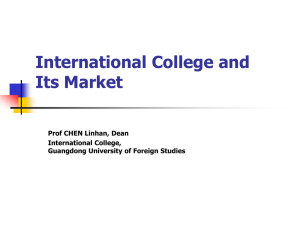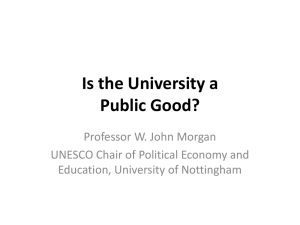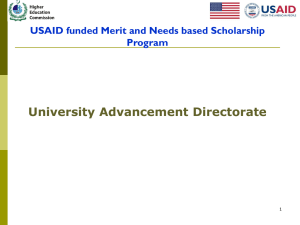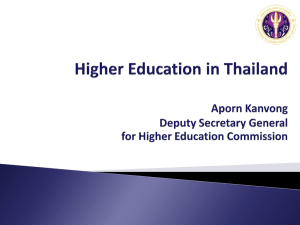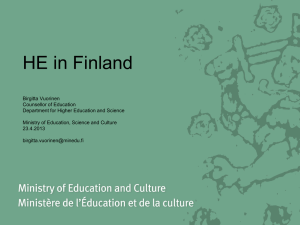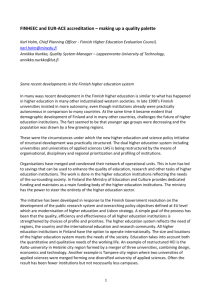The Finnish Innovation System The Role of Higher Education
advertisement
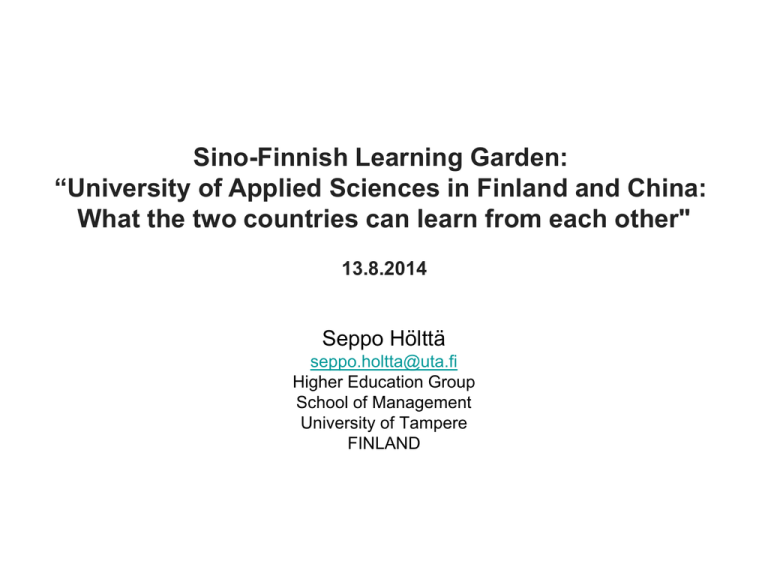
Sino-Finnish Learning Garden: “University of Applied Sciences in Finland and China: What the two countries can learn from each other" 13.8.2014 Seppo Hölttä seppo.holtta@uta.fi Higher Education Group School of Management University of Tampere FINLAND The Finnish HE system • University sector – 14 research universities, including University of Arts • Student enrollment 164 000 • Polytechnic sector, Universities of Applied Sciences (established in the mid 1990s) – 24 institutions • Student enrollment 118 000 – Regional development tasks – Bachelor degrees (vocational and professional degrees) – (Professional) Master’s degrees on selected fields • Governed by separate laws GDP share of R&D expenditure in certain countries Source: OECD, Main Science and Technology Indicators International Influence • • • • • • • Academy of Turku (Currently University of Helsinki) established in 1640 by King of Sweden Deep Humboldtian roots (German/Nordic) – Connection between research and teaching – Role of government – Academic autonomy of universities, academic freedom Nordic connections – History – E.g. connection between HE policy and regional development policy since the 1960c – Nordic Welfare Society International influence to the Finnish HE policy through Influence of the main (European) national models of professional and vocational institutions in te polytechnic reform in the 1990s Influence of the European Union – HE policy connected to the innovation policy and competitiveness of Europe Globalisation and HE (policy) - Markets Characteristics of Finnish Higher Education Policy • Social values – Nordic welfare society – Extensive provision of HE – Tuition free system • Broad understanding of diverse functions of HE – Social, economic and cultural functions of HE • Long term perspective and commitment of Government – Stable growth of funding since the 1960s • Education and research are regarded as the main resources of the nation • Connections between HE policy and other policies – Regional development policy since 1960s – National Innovation Policy since the early 1990s – Globalisation Developments of the Finnish HE System 1960s – mid-1980s: Establishing the structures – start of massification – Expansion of the system – Regionalisation – regional development – Democratisation of universities – Modernisation of curriculum (study programmes, measuring students’ work load) – Planning and control of government Mid-1980s – mid-1990s: Modernisation - massification – Transfer towards extended institutional autonomy – Establishment of the vocational and professional oriented HEIs (Polytechnics = Universities of Applied Sciences) – Innovation system framework for HE and research policies – Higher priority for research and funding of research The Polytechnic Reform • From an elite system to a mass HE system • Upgrading the level of vcational education • Response to technological development and changing labour markets • Strong regional orientation (and regional ownership) • Limited research (benefitting regional companies) • Mergers of the former colleges and to create HEIs • ”Equal but different” compared to universities • Challenges – – – – – – Organisational reform / mergers Governance and management Multidisciplinary / adaptation of field based cultures Training of teachers Pedagogical training Public image as HEIs Late 1990s - 2000s: Internationalisation – Establishment of the European Educational Area and European Research Area • Bologna process -- Harmonisation of degree and credit systems, QA framework – Changes in Government – Universities relationship • Performance contracting – Formula funding (goals and outputs in the terms of Master and Phd degrees and research output) • National evaluation system – FINHEEC (Finnish HE Evaluation Council) – Shared responsibility with HEIs – Deeper linking HE education policy to innovation policy – Further development of the polytechnic system (universities of applied sciences) – Increase autonomy of institutions Since 2010: Adaptation to the system for Global Market Economy • New legal status for universities and Universities of Applied Sciences – Universities • Legal public entities – Separated from government budget • Foundation universities – Initial capital from governemt and private companies – Universities of Applied Sciences • From diverse ownership/maintenance models to a Company Model • • • Increase of international programmes – Mainly Master Programmes Experimentation with tuition fees – Only for non-European students – Scholarship funds required Sharper profile of institutions – – • • • • Reseach universities, regional iinstitutions Better fit with industry Government subsidies have remained as before Institutional mergers at both sectors Innovative collaboration models among institutions (universities and UASs) Different functions and tasks of universities and UASs have been remain




